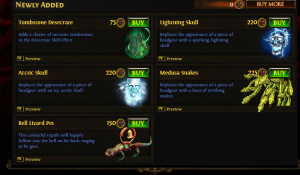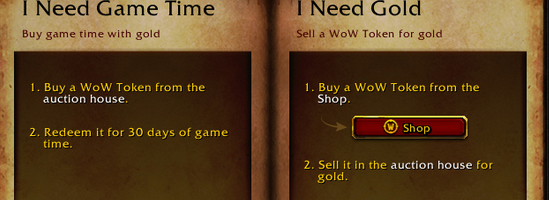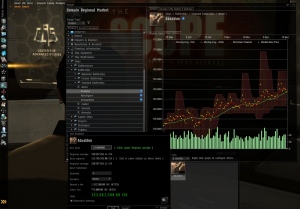Recently Blizzard implemented a new item into World of Warcraft’s end game in the form of WoW tokens. At a cost of gold (which is Wow’s in game currency) players can buy these tokens which equate to 30 days of playing Wow or $15 a month. In other words, this is World of Warcraft’s way of letting you pay your monthly subscription using in game money instead of real cash. Now this system was originally seen in EVE Online in the form of PLEX and the use of this is a big deal when it comes to F2P and monetization design.
Blurring Currency:
One of the basic concepts we see in any F2P game is that in game and premium currency are not interchangeable. This is to prevent people from circumventing the need to spend real money or pay the developers for playing.
What happens is that the currency transfer is one way and usually it’s spending premium currency to get more of in game currency. As you can probably guess, this kind of transaction benefits the developers the most as it’s like someone spending money to buy chips at a casino that cannot be cashed out at the end.
Eve Online was the first game to allow people to buy in game time via Plex tokens and expert players who understood the economy could essentially earn enough Plex that they would never have to pay the developers to access the game each month.

Typically most games with in game and premium currency only make the conversion one way, as to maximize revenue
Incidentally when Age of Empires Online was rebooted by Gas Powered Games, one of the changes they added was being able to earn premium currency through play to unlock content as opposed to spending real money. Unfortunately, this along with the other changes came too little too late to save the game.
Being able to use in game currency for real world (or premium) purchases is a very interesting decision and one that you can’t take lightly.
Cashing In and Out:
Whereas the basic monetization model of F2P games favor the developers, allowing players to convert in game currency to premium is better for the players. The Eve Online example is a good one as the players who are at the top are essentially playing the game for free and that’s where the use of Plex or Wow tokens is appealing to players.
First is that it acts as a reward for your most hardcore fan base to allow them to take their mastery and not having to worry about paying real money to continue enjoying the game. This is also a great goal for new players to go after and provides an incentive for people to keep playing if it means that one day the game will be free for them.

Content bought with premium currency is important as this is the main source of income from players with exception to subscription plans
Second is that if the currency and pricing is developed right, the developer can still make money off of it even though players are spending in game currency for real world value.
Since the currency can be bought and sold, the developer can set it up to take a fee for every transaction and there is the fact that going for this currency can keep your fan base even more interested in your game which can help the community as a whole.
Also, by having the option for the player to earn in game premium currency through play, this can also help make your game more alluring for F2P games as you are effectively advertising that someone can get good enough at the game that it will really become F2P.
The dangers of this model can impact both your player base and the game itself if you aren’t careful when it comes to balance.
Giving it away for Free:
While it may seem like an easy win to give players a chance to pay for the game through playing it, you need to be careful with how you set up the process.
First is the actual balance of the cost involved in getting the premium currency. “Cost” means two things — What the player has to do and the actual in game currency value. Some games make the ability to acquire premium currency so difficult in order to dissuade players from going after it while still claiming that the option is there. While obviously not everything should give the player premium currency, it’s important to look at your game and decide how long it takes to acquire it and how much at a time.
The second point concerning the actual price can make or break the model. If you have the cost as too high, only whales will be able to afford it and players may accuse you of making the game pay to win. But if you make the cost too low, then everyone can easily acquire it and your profits will nosedive because of it.
Another huge factor is if your tokens/ Plex/ whatever become a part of your game’s economy, meaning that its value will shift based on market prices and availability. It’s important to remember one of the most basic rules of the economy: Something is only worth what someone is willing to spend on it. You may want your item to be worth $10, but if your consumer base is only buying it at $6 then that’s what the price is going to be.
It only took a few days for the WoW tokens to depreciate in value due to high level players flooding the market with them. According to a recent Gamespot piece, the tokens started at 30,000 gold or $20.
From there the price went up to 31k gold, then down to around 20k and changing a few more times before settling at around 24k gold.
Because the tokens are now a part of the Auction House system and economy, Blizzard doesn’t have direct control of where the price is going to end up. It may go back up to its normal pricing or beyond which would be great for Blizzard, or it may continue to drop and even go below what the normal $15 a month subscription rate is. Now of course Blizzard could at any time institute a forced minimum price on the WoW tokens to control them, however this could be seen as price fixing and cause even more trouble for them.
Free Economy:
Whenever you blur the line between in game and real world currency, you need to be aware of the implications. When virtual currency can affect real world decisions and pricing, it becomes a lot more valuable and the economy will shift.
We haven’t even touched on the impact that this kind of system can have on gold farmers who were already making real money buying and selling virtual currency. The use of the WoW tokens and Plex also have the side effect of affecting farmers as now the player base as a whole can in essence sell gold for real world value (AKA the subscription fee.)
It’s still too early to tell the full implications of this model in WoW but this could be a shot in the arm to get people interested in it without needing to pay the monthly fee. But for any developers who are looking at a similar system, it’s important to keep the points mentioned in mind as providing value to your consumers is great; losing your shirt in the process not so much.



